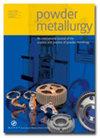使用压实和烧结的离散模拟来预测最终零件的几何形状
IF 1.8
4区 材料科学
Q2 METALLURGY & METALLURGICAL ENGINEERING
引用次数: 0
摘要
摘要采用离散元法(DEM)模型模拟陶瓷氧化物的压实和烧结过程。过程运动学被分解为颗粒的装载、卸载和排出。通过实现能够处理大密度的模型,粒子之间的相互作用被认为是弹塑性的。烧结阶段使用了一种简化的方法,该方法侧重于最终零件的几何形状,而不是动力学。结果与实验数据和文献中关于密度梯度、弹性回弹和最终几何形状的有限元模拟非常一致。模拟结果表明,团聚体与模具之间的摩擦系数是颗粒密度梯度的主要因素。这种密度梯度导致不均匀的烧结,从而产生具有空竹效应的最终几何形状。DEM首次再现了这种效果,其优点是明确考虑了粉末的颗粒性质。图形摘要本文章由计算机程序翻译,如有差异,请以英文原文为准。
Using discrete simulations of compaction and sintering to predict final part geometry
ABSTRACT
A Discrete Element Method (DEM) model is used to simulate the compaction and sintering of ceramic oxides. The process kinematics is decomposed into loading, unloading and ejection of the pellet. Interactions between the particles are considered elastoplastic by implementing a model able to tackle large densities. A simplified approach is used in the sintering stage, which focuses on the final part geometry rather than kinetics. The results are in good agreement with experimental data and FEM simulations from the literature regarding density gradient, elastic spring-back and final geometry. The simulations show that the friction coefficient between the agglomerates and the die is the primary factor for the density gradient in the pellet. This density gradient induces non-homogeneous sintering, which results in a final geometry with a diabolo effect. It is the first time that DEM reproduces this effect with the advantage of considering explicitly the particulate nature of the powder. GRAPHICAL ABSTRACT
求助全文
通过发布文献求助,成功后即可免费获取论文全文。
去求助
来源期刊

Powder Metallurgy
工程技术-冶金工程
CiteScore
2.90
自引率
7.10%
发文量
30
审稿时长
3 months
期刊介绍:
Powder Metallurgy is an international journal publishing peer-reviewed original research on the science and practice of powder metallurgy and particulate technology. Coverage includes metallic particulate materials, PM tool materials, hard materials, composites, and novel powder based materials.
 求助内容:
求助内容: 应助结果提醒方式:
应助结果提醒方式:


